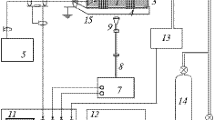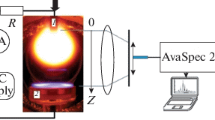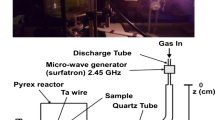Abstract
The effect of a small nitrogen additive on a microwave discharge in hydrogen ignited near the antenna at a pressure of 1 Torr was studied by emission spectroscopy and visualization methods. It is shown that, in the presence of a nitrogen additive, the discharge shifts along the antenna toward the generator and the intensities of hydrogen spectral lines and bands near the antenna decrease. These results are qualitatively explained on the basis of the earlier 1D simulation of the discharge. The changes in the discharge parameters are caused by the replacement of the light \({\text{H}}_{3}^{ + }\) ion in hydrogen plasma with the heavy N2H+ ion in a discharge in a hydrogen–nitrogen mixture. As a result, the rate of diffusive particle loss decreases, so that the discharge can exist in regions with a weaker microwave field.
Similar content being viewed by others
Avoid common mistakes on your manuscript.
1 INTRODUCTION
It is well known that small additives of other gases to the plasma-forming gas can appreciably change the properties of the discharge plasma. In particular, gas additives can affect the ionization and excitation processes and, consequently, the electric field, which, in the case of a self-sustained discharge, is determined by the charged particles balance.
A convenient instrument to study the effect of small gas additives is the electrode microwave discharge (EMD) ignited near the microwave antenna at reduced pressures [1–3]. The EMD is not bounded by the discharge chamber walls because it is smaller in size than the discharge chamber. This discharge is highly inhomogeneous; it consists of a bright plasma layer near the antenna and is surrounded by a less bright spherical plasma region. The layer forms in the plasma resonance region, where the electron density slightly exceeds the critical density (~1011 cm–3). The microwave field in the discharge is also inhomogeneous. Currently, such a discharge is considered to be a combination of a self-sustained and a non-self-sustained discharge. The former operates in the near-electrode layer, while the latter operates in the surrounding spherical region. Note that the kinetics of excitation and ionization of hydrogen in the near-electrode plasma layer is dominated by direct electron impacts (e.g., hydrogen atoms are excited via electron-impact dissociative excitation). The gas temperature in the discharge reaches 600 K.
It is convenient to use the EMD to study the effect of small gas additives because its response to them (in contrast to discharges bounded by the chamber walls) is clearly visible, e.g., the size of the discharge changes. This effect was first discovered and thoroughly investigated when studying the influence of small argon additives [4].
In [5, 6], the effect of a small hydrogen additive on a low-pressure EMD in nitrogen was studied both experimentally (by optical emission spectroscopy) and numerically (by 1D and 2D simulations). It was shown that, due to the discharge inhomogeneity, the effect of the hydrogen additive on the intensities of nitrogen spectral bands is different in different regions of the discharge. The effect of a hydrogen additive on the distribution of nitrogen molecules over vibrational levels of the C3Πu state is also different in different discharge regions. The hydrogen additive changes the plasma ion composition. For example, far from the antenna, the main \({\text{N}}_{4}^{ + }\) ion of the nitrogen plasma is replaced with the lighter N2H+ ion. This leads to an increase in the microwave field in this discharge region and changes in the intensity of the second positive system of nitrogen. Thus, the main effect of the hydrogen additive on a discharge in nitrogen consists in the change of the plasma ion composition.
In this work, we discuss results of the experimental study of the effect of a small nitrogen additive on a highly inhomogeneous EDM in hydrogen at reduced pressures.
2 EXPERIMENTAL SETUP
The experiments were carried out at the experimental setup described in detail in [1–6]. The discharge chamber is a 15-cm-diameter stainless-steel cylinder with four diagnostic windows on its side wall. A microwave with a power of up to 200 W and frequency of 2.45 GHz is supplied to the discharge chamber through a waveguide–coaxial junction, the central conductor of which (a copper cylindrical tube with a 5-mm outer diameter and 3-mm inner diameter) serves as an antenna electrode. The antenna is introduced in the chamber through its upper end via a vacuum seal along the chamber axis, which coincides with the discharge axis.
The chamber is equipped with quartz windows to observe the discharge. A K-008 electron-optical camera operating in the steak mode is used to visualize the spatial spectrum-averaged distributions of the discharge emission intensity, and an AvaSpec-2048 spectrometer with a resolution of 1 nm is used to study the radiation spectra in the wavelength range of 300–700 nm. A quartz condenser focuses the plasma image onto the plane where the entrance aperture of a movable optical fiber is located. The optical fiber can be moved both parallel to the discharge axis and in the radial direction. The spatial resolution of the system is no worse than 0.1 mm. In this work, the radiation emitted from the discharge region adjacent to the antenna end was recorded.
The measurements were carried out in hydrogen (the main gas) at a flow rate of 70 sccm with a nitrogen additive at flow rates of 0–70 sccm. The total pressure in the chamber was 1 Torr, and the input microwave power was 80 W. The gases were supplied through a channel in the upper lid of the chamber by using a system consisting of controlled flowmeters, a throttler valve, and a Baratron pressure gauge. The system allowed us to maintain the gas pressure in the chamber at a constant level when varying the gas flow rates.
3 RESULTS AND DISCUSSION
Figure 1 shows a photograph of the discharge. It is seen that the antenna is surrounded by the discharge region with a thin plasma layer, the maximum of the layer glow being somewhat shifted from the antenna end toward the generator. Figure 2 shows the measured axial distributions of the spectrum-integrated intensity in a discharge in pure hydrogen and in the H2 + 5% N2 and H2 + 10% N2 mixtures. It is seen that the maximum of the radiation intensity on the antenna shifts toward the microwave generator when nitrogen is added to the discharge.
Figure 3 shows typical discharge emission spectra recorded near the antenna end. In the presence of a nitrogen additive, intense bands of the second positive system of nitrogen appear already at a flow rate ratio as low as N2/H2 = 0.02. The intensities of the bands increase with increasing nitrogen concentration. At the same time, the intensities of hydrogen lines and bands in this region decrease. At low nitrogen additives, the decrease in the intensities of hydrogen lines appreciably exceeds the effect related to the diluting of hydrogen with nitrogen. As the nitrogen concentration increases, the band of the first positive system of nitrogen appears in the spectrum. At a flow rate ratio of N2/H2 = 0.5, the discharge emission spectrum is dominated by the nitrogen spectral lines and bands, while hydrogen is represented only by the Hα line.
Figure 4 shows the intensities of the lines and bands of hydrogen (493, 481, and 656 nm) and nitrogen (337 nm) in near the antenna end as functions of the nitrogen flow rate.
Before discussing the results, note that measurements of the standing wave ratio in the supply line show that a small nitrogen additive does not affect the power deposited in the discharge. This means that the observed changes in the radiation intensity are caused by the spatial redistribution of the absorbed power in the presence of nitrogen. It is seen from Fig. 2 that, when nitrogen is added to hydrogen, most of the antenna is covered in a plasma sheath. It is known that in a discharge initiated by a microwave antenna, most of the microwave power is absorbed by a thin surface plasma layer, where the microwave field is the strongest [7]. The higher the microwave power, the smaller the power fraction that reaches the antenna end, where the discharge is initiated. This results in a decrease in the electric field strength in this region. Since plasma radiation is excited by electron impact and the excitation coefficient depends on the microwave field strength, this leads to a decrease in the intensities of hydrogen spectral lines and bands. The increase in the intensities of nitrogen lines and bands in the spectrum is caused by an increase in the nitrogen concentration.
It remains unknown why the discharge boundary moves toward the generator (toward the weaker field) when nitrogen is added to hydrogen.
Discharges in hydrogen–nitrogen mixtures have received active study [8–14] because such mixtures are used in ammonia production and surface modification (in particular, in surface nitriding).
The effect of a nitrogen additive on the parameters of a dc discharge in hydrogen was studied in [15] by using self-consistent zero-dimensional simulations. The authors analyzed the effect of the change in the electron energy distribution function (EEDF) caused by the nitrogen additive on the discharge parameters.
It is known [16, 17] that, when nitrogen is added to hydrogen, heavy nitrogen-containing ions (e.g., N2H+,  , etc.) appear the discharge plasma in addition to the
, etc.) appear the discharge plasma in addition to the  and
and  hydrogen ions. The ion kinetics is usually simulated in a zero-dimensional model. In [18], we studied the effect of a nitrogen additive on the structure and parameters of a highly inhomogeneous microwave discharge in the 1D spherical geometry by using a simplified kinetic model in which only one heavy nitrogen-containing ion (N2H+) was taken into account. This allowed us to qualitatively analyze the effect of heavy nitrogen-containing ions on the discharge structure.
hydrogen ions. The ion kinetics is usually simulated in a zero-dimensional model. In [18], we studied the effect of a nitrogen additive on the structure and parameters of a highly inhomogeneous microwave discharge in the 1D spherical geometry by using a simplified kinetic model in which only one heavy nitrogen-containing ion (N2H+) was taken into account. This allowed us to qualitatively analyze the effect of heavy nitrogen-containing ions on the discharge structure.
The results of [18] can be used to explain the experimentally observed phenomena. Note that this explanation is qualitative, because strict solution require using a 2D model and a more complete kinetic scheme of the processes.
The model took into account two possible effects of the nitrogen additive on the discharge properties, namely, changes in the EEDF, which depend on the nitrogen concentration, and changes in the plasma ion composition. At a low nitrogen concentrations, the EEDF changes insignificantly and the effect of its change on the discharge parameters is weak; moreover, this effect decreases with increasing microwave power. Therefore, this effect is weak near the antenna, where the microwave field is strong, and manifests itself only in the spherical region of the discharge. The microwave field strength near the antenna can be estimated from the intensity ratio of the Hα (656.2 nm) and Hβ (486.1 nm) hydrogen lines near the antenna under the assumption that radiating atoms are excited via dissociative electron-impact excitation [19]. Such estimates yield a field strength of about 500–600 V/cm. Note that, under the assumption that the process is stepwise and consists of hydrogen dissociation followed by electron-impact excitation, similar estimates yield the field values that are insufficient to sustain the discharge. This confirms that excitation is a direct electron-impact process. Unfortunately, the error in measuring the microwave field strength in our experiments reached 10–15%, which did not allow us to fix a small decrease in the microwave field consistent with the decrease in the intensities of hydrogen atoms.
The main factor governing the effect of the nitrogen additive on the shift of the maximum radiation intensity along the antenna toward the generator is the change in the plasma ion composition.
The processes of ion conversion in the plasma leads to the appearance of heavy N2H+ ions, which replace the main hydrogen ions \({\text{H}}_{3}^{ + }\). This leads to a decrease in diffusive losses of ions and, accordingly, a decrease in the electric field strength required to maintain the charged particle balance in the discharge, due to which the discharge boundary shifts along the antenna toward weaker fields. The shift of the boundary decreases with increasing nitrogen concentration, because the N2H+ ion becomes the main ion already at low nitrogen concentrations and the further increase in the nitrogen concentration does not affect the type of main ion or the position of the discharge boundary. Taking into account a larger number of nitrogen-containing ions will not change this qualitative explanation of the mechanism for the observed changes in the structure of a discharge in hydrogen with a nitrogen additive.
4 CONCLUSIONS
It is experimentally shown that a small (<5%) additive of nitrogen to a discharge ignited in hydrogen at a pressure of 1 Torr by means of a microwave rod antenna leads to the shift of the discharge boundary along the antenna toward the generator. The field strength in the discharge initiation system is at maximum near the antenna end, where the discharge is ignited. To explain the observed effect, the results of the earlier 1D simulations of the effect of nitrogen on the microwave discharge in hydrogen were used. The model takes into account changes in the EEDF, as well as changes in the plasma ion composition and the replacement of the main light  ion with the heavy nitrogen-containing N2H+ ion, when nitrogen is added hydrogen. Analysis shows that it is the latter mechanism that causes changes of the discharge properties in the region with the strong microwave field near the antenna. Heavy ions decrease diffusive losses of charged particles on the antenna surface. This, in turn, causes a decrease in the microwave field required to sustain the microwave discharge, due to which the discharge shifts toward the generator, into the region with a weaker field.
ion with the heavy nitrogen-containing N2H+ ion, when nitrogen is added hydrogen. Analysis shows that it is the latter mechanism that causes changes of the discharge properties in the region with the strong microwave field near the antenna. Heavy ions decrease diffusive losses of charged particles on the antenna surface. This, in turn, causes a decrease in the microwave field required to sustain the microwave discharge, due to which the discharge shifts toward the generator, into the region with a weaker field.
REFERENCES
Yu. A. Lebedev, I. L. Epstein, A. V. Tatarinov, and V. A. Shakhatov, J. Phys. Conf. Ser. 44, 30 (2006).
Yu. A. Lebedev, M. V. Mokeev, A. V. Tatarinov, V. A. Shakhatov, and I. L. Epstein, J. Phys. D 41, 194001 (2008).
Yu. A. Lebedev, I. L. Epstein, A. V. Tatarinov, and V. A. Shakhatov, J. Phys. Conf. Ser. 207, 012002 (2010).
Yu. A. Lebedev, A. V. Tatarinov, A. Yu. Titov, I. L. Epstein, G. V. Krashevskaya, and E. V. Yusupova, J. Phys. D 47, 335203 (2014).
J. Jovovich, I. L. Epstein, N. Konjevich, Yu. A. Lebedev, N. M. Sisovic, and A. V. Tatrinov, Plasma Chem. Plasma Process. 32, 1093 (2012).
Yu. A. Lebedev, T. B. Mavlyudov, V. A. Shakhatov, and I. L. Epshtein, High Temp. 48, 315 (2010).
Yu. A. Lebedev and A. V. Tatarinov, Plasma Sources Sci. Technol. 13, 1 (2004).
Yu. B. Golubovskii and V. M. Telezhko, Sov. Phys. Tech. Phys. 29, 727 (1984).
S. D. Popa, L. Hochard, and A. Ricard, J. Phys. III France 7, 1331 (1997).
A. R. de Souza, M. Digiacomo, J. L. R. Muzart, J. Nahorny, and A. Ricard, Eur. Phys. J. Appl. Phys. 5, 185 (1999).
K. Rusnak and J. Vicek, J. Phys. D 26, 585 (1993).
V. Melnik, D. Wolanski, E. Bugiel, A. Goryachko, S. Chernjavski, and D. Krüger, Mater. Sci. Eng. A 102, 358 (2003).
H. Nagai, M. Hiramatsu, M. Hori, and T. Goto, J. Appl. Phys. 94, 1362 (2003).
H. Martinez and F. B. Yousif, Eur. Phys. J. D 46, 493 (2008).
A. Garscadden and R. Nagpal, Plasma Sources Sci. Technol. 4, 268 (1995).
E. Carrasco, M. Jiménez-Redondo, I. Tanarro, and V. Herrero, Phys. Chem. Chem. Phys. 13, 19561 (2011).
M. Sode, W. Jacob, T. Schwarz-Selinger, and H. Kersten, J. Appl. Phys. 117, 083303 (2015).
Yu. A. Lebedev, A. V. Tatarinov, and I. L. Epstein, J. Phys. Conf. Ser. 927, 012029 (2017).
Yu. A. Lebedev, I. L. Epshtein, and E. V. Yusupova, High Temp. 52, 150 (2014).
FUNDING
This work was carried out within the State Program of the Topchiev Institute of Petrochemical Synthesis, Russian Academy of Sciences.
Author information
Authors and Affiliations
Corresponding author
Additional information
Translated by E. Voronova
Rights and permissions
About this article
Cite this article
Lebedev, Y.A., Tatarinov, A.V. & Epstein, I.L. Effect of Nitrogen Additive on Inhomogeneous Microwave Discharge in Hydrogen at Reduced Pressures. Plasma Phys. Rep. 45, 397–400 (2019). https://doi.org/10.1134/S1063780X19030061
Received:
Revised:
Accepted:
Published:
Issue Date:
DOI: https://doi.org/10.1134/S1063780X19030061








